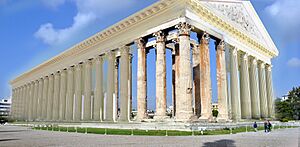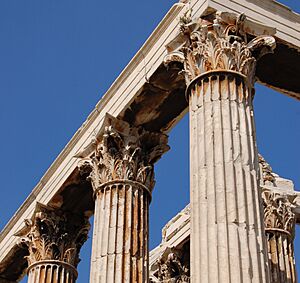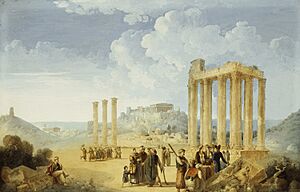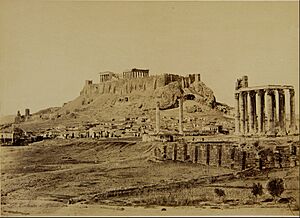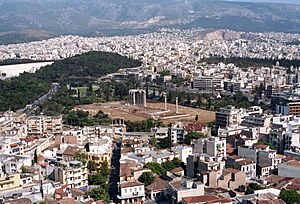Temple of Olympian Zeus, Athens facts for kids
Quick facts for kids Temple of Olympian Zeus |
|
|---|---|
|
Ναός του Ολυμπίου Διός
|
|
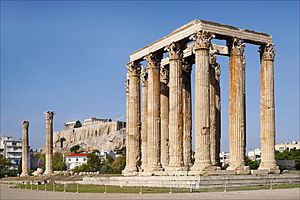
Temple of Olympian Zeus
|
|
| General information | |
| Type | Temple |
| Architectural style | Classical |
| Location | Athens, Greece |
| Construction started | 561–527 BC |
| Completed | 131 AD |
| Design and construction | |
| Architect | Antistatis, Kallaischros, Antimachides and Phormos |
The Temple of Olympian Zeus (also called the Olympieion) was a huge temple in the center of Athens, Greece. It was built to honor Zeus, who was the king of the Olympian gods.
Building this massive temple started way back in the 6th century BC. Powerful rulers in Athens wanted to create the biggest temple in the ancient world. However, it took a very long time to finish. The temple was finally completed by the Roman Emperor Hadrian in the 2nd century AD. This was about 638 years after construction first began!
During the Roman period, the temple was famous for being the largest in Greece. It had 104 enormous columns and a giant statue of Zeus inside. But its glory didn't last long. Around 267 AD, invaders attacked Athens and damaged the temple. It was likely never repaired after that. Over many centuries, people took stones from the ruins to build other parts of the city.
Today, you can still see a large part of the temple. Sixteen of its original gigantic columns still stand tall. It is now an important historical site in Athens.
Contents
Exploring the Temple's Past
Building a Giant Temple
The Temple of Olympian Zeus is located about 500 meters (0.3 miles) southeast of the Acropolis. This area was once a sacred outdoor spot dedicated to Zeus. An older temple stood here, built around 550 BC.
Later, around 520 BC, the sons of a ruler named Peisistratus started building a much bigger temple. They wanted it to be grander than other famous temples of their time. Architects like Antistates and Phormos designed it. They planned to use local limestone and build it in the Doric style. The temple was meant to sit on a huge platform, about 41 meters (135 feet) by 108 meters (354 feet). It would have many columns surrounding its main hall.
Work stopped in 510 BC when the rulers were overthrown. For over 300 years, the temple remained unfinished. The ancient Greeks thought building something so huge might be a sign of too much pride.
The Roman Emperor's Vision
In 174 BC, a king named Antiochus IV Epiphanes decided to restart the project. He saw himself as a living version of Zeus. He hired a Roman architect, Decimus Cossutius. The new design included even more columns, 104 in total. These columns would be 17 meters (56 feet) tall and 2 meters (6.6 feet) wide.
The building material was changed to expensive Pentelic marble. The style also changed from Doric to Corinthian. This was the first time the Corinthian style was used on the outside of such a major temple. But the project stopped again in 164 BC when Antiochus died.
Later, in 86 BC, a Roman general named Lucius Cornelius Sulla attacked Athens. He took some of the unfinished columns and moved them to Rome. There, they were used in another temple.
Finally, in the 2nd century AD, the Roman Emperor Hadrian took charge. He was a big fan of Greek culture. Hadrian completed the temple in 132 AD, after 638 years of construction!
A Grand Dedication
When Hadrian finished the temple, he dedicated it in a special ceremony. He even took the title "Panhellenios," meaning "common to all Greeks." A marble-paved area was built around the temple, making it a central part of Athens.
The temple and its surroundings were filled with many statues. These included statues of Hadrian, various gods, and symbols of Roman provinces. Inside the main hall, there was a gigantic statue of Zeus. It was made of chryselephantine, which means ivory and gold. Hadrian might have wanted to copy the famous statue of Athena in the Parthenon.
A writer named Pausanias described the temple in the 2nd century. He mentioned the huge statue of Zeus, saying it was bigger than almost any other. He also wrote about statues of Hadrian and other ancient items within the temple grounds.
The temple was badly damaged when invaders called the Heruli attacked Athens in 267 AD. It was probably never fixed. An earthquake in the 5th century completely destroyed it. Over time, people used its stones to build other structures in Athens.
Through the Centuries
For hundreds of years, the temple served as a quarry. People took its marble to build houses and churches in medieval Athens. By the end of the Byzantine period, most of it was gone. In 1436, a visitor found only 21 of the original 104 columns still standing.
One column's fate is even recorded! An inscription says that on April 27, 1759, a Turkish governor used gunpowder to pull down a column. He needed the marble to make plaster for a mosque he was building.
During the time of the Ottoman Empire, Greeks called the temple "Hadrian's Palace." Turks called it "Belkis' Palace," based on a legend about Solomon's wife.
Today, fifteen columns still stand. A sixteenth column lies on the ground, where it fell during a storm in 1852. Nothing remains of the main hall or the giant statue of Zeus.
Uncovering the Ruins
Archaeologists have studied the temple over many years. Francis Penrose from the British School in Athens led excavations from 1889 to 1896. Later, German archaeologist Gabriel Welter worked there in 1922. In the 1960s, Greek archaeologists, led by Ioannes Travlos, continued the work.
The temple and other ancient ruins nearby are now a historical area. The Greek Ministry of Interior's Ephorate of Antiquities manages and protects it.
The Temple Today
The Temple of Olympian Zeus is now an open-air museum. It is part of a project to connect Athens' archaeological sites. As a historical place, it is carefully protected and watched over.
Special Events at the Temple
On June 28, 2001, a famous musician named Vangelis held a concert called "Mythodea" at the temple. This event was part of NASA's mission to Mars. Two famous singers, Jessye Norman and Kathleen Battle, performed. Many TV networks around the world broadcast the concert. Thousands of people gathered to watch the show.
On January 21, 2007, a group of Greek pagans held a ceremony honoring Zeus at the temple. This group, called Ellinais, had won a court case to have ancient Greek religious practices recognized.
See also
- List of Ancient Greek temples
- Architecture of Ancient Greece


